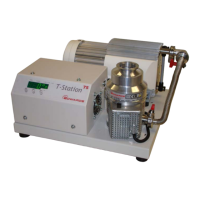D395-93-880 Issue A
Page 8 © Edwards Limited 2011. All rights reserved.
Edwards and the Edwards logo are trademarks of Edwards Limited.
Technical data
2.5 Pumping media
Do not use the turbo pump to pump gases containing more than 20% oxygen unless the pump is gas purged. If
you do, the lubricant will polymerise and the pump may fail prematurely.
Do not use a turbo pump to pump mercury vapour and do not allow mercury (for example, from a McLeod gauge)
to come into contact with the pump. If you do, the pump rotor may corrode and fail.
Note: Concentrations of gases may be modified by the compression of the pump.
The turbo turbo pump is designed to pump the following residual gases normally used in high-vacuum systems:
You can use the pump to pump oxygen and water vapour, subject to the following conditions:
Oxygen - when the pump is purged by an inert gas, oxygen can be pumped at concentrations above 20% by
volume. Refer to the EXT75DX instruction manual (B722-40-880) for Purge gas specification. However, if the
pump is not purged, the oxygen concentration must be less than 20% by volume.
Water vapour - you must ensure that vapour does not condense inside the pump.
Vent dangerous gases and gas mixtures safely, do not expose people to these gases. If pumping
hazardous gases or vapours, observe the safety recommendations of the supplier of the gas/
vapour.
Do not use the turbo pump to pump pyrophoric or explosive gas mixtures, as it is not suitable for
this purpose. The pump and its connections are not designed to contain an explosion.
Do not expose any part of the human body to vacuum.
Air Carbon dioxide
Methane Neon
Propane Krypton
Butane Helium
Carbon monoxide Ethane
Nitrogen Argon
Hydrogen

